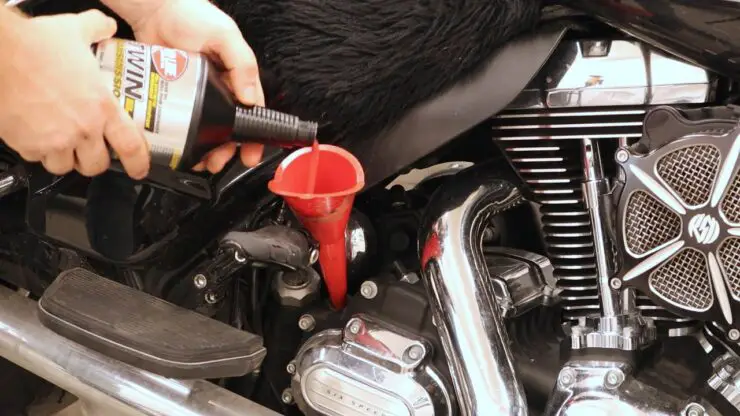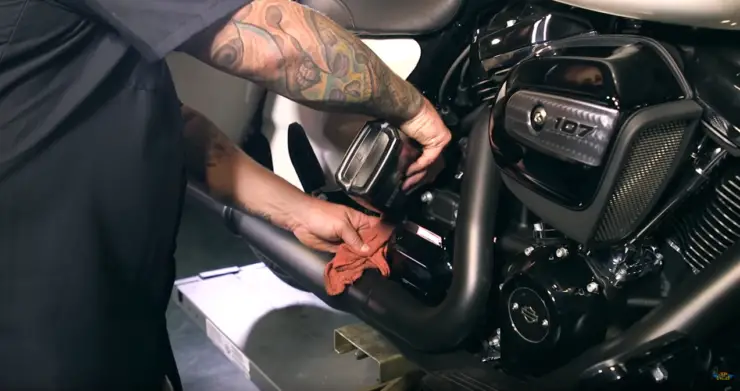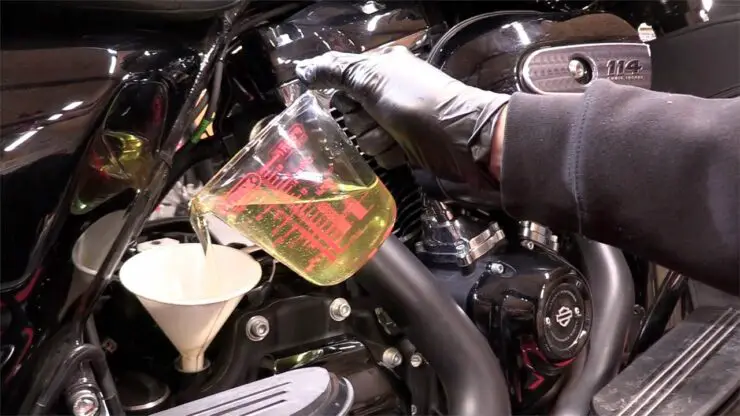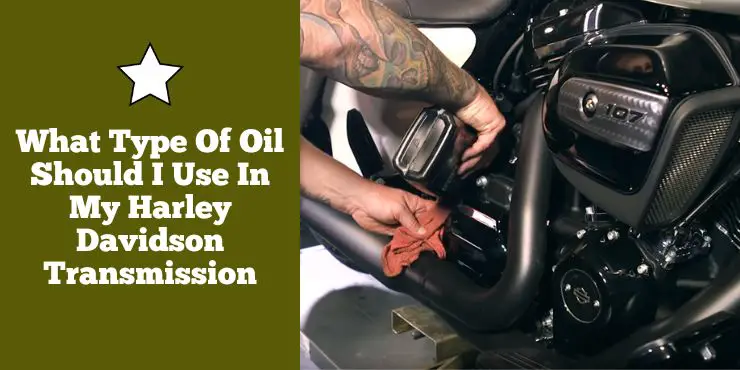Are you a Harley-Davidson enthusiast looking for the right type of oil for your transmission? Whether you are a veteran rider or a newbie, choosing the correct oil for your motorcycle’s transmission is essential for long-term engine performance.
Use Harley-Davidson’s Formula+ Transmission and Primary Chaincase Lubricant, or a high-quality 75W-140 synthetic gear oil, to ensure smooth shifting and protection for transmission gears.
In this article, we’ll discuss the factors to consider when selecting the best oil for your Harley-Davidson transmission. Keep reading to learn more and make sure your motorcycle is running optimally!
What does transmission oil do in a Harley-Davidson bike?
When it comes to Harley-Davidson bikes, riders should expect nothing less than optimal performance and an impressive ride. If you dissect the anatomy of the bike, there are numerous critical components that work in tandem to ensure seamless gear shifting and overall transmission efficiency, such as transmission fluid.
>>> Click here to read our review of the Best Oil For Harley-Davidson <<<
Transmission fluid is a specialized lubricant formulated for meeting the unique demands of automatic and manual transmissions. In a Harley-Davidson motorcycle, transmission fluid serves as an important lubricant that facilitates smooth gear changes, reduces friction, and dissipates heat. Unlike engine oil, which primarily lubricates the engine’s moving parts, transmission fluid is specifically designed to cater to the intricate components and gears in the transmission system.
The main function of transmission fluid is to lubricate the various moving parts inside the transmission system. As gears engage and disengage, they create friction and heat, which can result in wear and damage over time. Transmission fluid forms a protective layer between these components, reducing friction and preventing metal-to-metal contact.
The transmission system generates heat as a natural byproduct of operation. Transmission fluid helps in dissipating this heat, preventing the transmission from overheating. Effective cooling will ensure that the transmission can function optimally, even during demanding conditions.
Transmission fluid offers a crucial sealing function within the transmission. It essentially forms a barrier that helps prevent fluid leaks and contamination from any external elements. Proper sealing will ensure that the transmission remains in prime working condition and extends its lifespan.
Transmission fluid contains additives that help keep the transmission clean by preventing the buildup of sludge, varnish, and deposits. These additives act as dispersants and detergents, preventing harmful contaminants from settling on vital transmission components.
Maintaining the right level of transmission fluid will be important for the overall health and performance of your Harley. Low or degraded transmission fluid can result in gear shifting issues, increased, increased friction, and potential transmission damage. Meanwhile, an overfilled transmission can result in excessive pressure and might result in fluid leaks. Regularly checking the transmission fluid level and quality while adhering to the recommended maintenance schedule specified in your motorcycle’s owner manual will be important.

Different types of transmission fluid for Harley-Davison bikes
Harley-Davidson bikes are capable of delivering smooth and powerful rides, and this is possible thanks in part to the transmission system. It facilitates seamless gear shifting. To ensure the optimal performance and longevity of your Harley-Davidson motorcycle, using the right transmission fluid will be important. Here are the different types of transmission fluids available for Harley-Davidson bikes.
#1. Harley-Davidson Transmission Lubricant
Harley-Davidson offers its own branded transmission lubricant, specifically designed to meet the unique demands of the transmission systems of its bikes. The Harley-Davidson Transmission Lubricant is specially formulated for providing excellent lubrication, cooling, and protection against wear and tear.
This transmission fluid is specially engineered for Harley-Davidson motorcycles, ensuring compatibility and optimal performance. It contains additives that reduce gear wear and extend the transmission life. Further, it also provides smooth gear changes and reduces transmission noise.
#2. Full Synthetic Transmission Fluid
Full Synthetic Transmission Fluids are engineered to deliver superior performance, even under extreme riding conditions. They’re made using highly refined synthetic base oils and advanced additives, offering excellent lubrication and temperature stability.
This type of transmission fluid offers exceptional lubrication and wear protection. It resists thermal breakdown, maintaining consistent performance in high temperatures. It is ideal for both high-performance and standard Harley-Davidson bikes.
#3. Synthetic Blend Transmission Fluid
A Synthetic Blend transmission fluid combines a mix of synthetic base oils with conventional mineral oils. This formula strikes the right balance between performance and cost-effectiveness.
It offers improved lubrication and protection in comparison to conventional fluids. You can expect enhanced thermal stability and resistance to oxidation. This is an extremely cost-effective option for riders looking for better performance without the premium price of full-synthetic fluids.
#4. High-Performance Transmission Fluid
For Harley-Davidson riders looking for top-notch performance and protection, high-performance transmission fluids will be a popular choice. This transmission fluid is designed to meet the demands of rigorous riding conditions and deliver maximum gear protection.
High-Performance Transmission Fluid contains advanced additives for improved gear wear protection and smoother shifts. It resists foaming and maintains consistent fluid pressure. Such transmission fluids are ideal for aggressive riding, long-distance touring, and high-stress conditions.
#5. Multi-Grade Transmission Fluid
Multi-grade transmission fluids are designed to perform effectively in different temperature ranges. They offer consistent performance in both cold and hot weather conditions.
Such transmission fluids ensure smooth gear changes and easy shifting in cold weather. They’re extremely versatile options for year-round riding and changing weather conditions. They maintain viscosity and lubricating properties at high temperatures.
What type of oil should I use in my Harley-Davidson transmission?
If you are a Harley-Davidson rider, you need to understand the importance of proper maintenance. In a bid to properly maintain your bike, you must choose the right oil for your Harley-Davidson bike’s transmission. The transmission is the heart of smooth gear shifting and making the choice of transmission oil will be important for ensuring optimal operation and longevity. This is why it is normal for riders to wonder what type of oil should I use in my Harley-Davidson transmission.
Harley-Davidson recommends that you should be adding a specific type of transmission oil for its motorcycle. Harley-Davidson bikes, especially the ones with Big Twin transmissions require transmission lubricants that meet specific requirements. You should go for lubricants that are specifically formulated and labeled as “Transmission Lubricant” or “Transmission Fluid” for use in Harley-Davidson bikes.
The brand has its own line of oil for transmission, specifically formulated for its motorcycles. Using the recommended Harley-Davidson Transmission Lubricant will ensure you’re using the right product designed to meet the manufacturer’s strict standards and provide optimal performance for your motorcycle’s transmission. These transmission lubricants have been engineered to offer excellent lubrication and protection, reducing friction and heat buildup in the transmission. They are available to suit different Harley-Davidson models, ensuring an ideal fit for your motorcycle’s transmission needs.
While transmission fluids for Harley offer reliable performance and impressive results, there are aftermarket options as well. Brands like Red Line, Mobil, Valvoline, Spectro Oil, etc. offer improved benefits. Synthetic fluids are specifically engineered to withstand higher temperatures and offer better resistance to breakdown, oxidation, and sludge formation.
Factors to consider when buying oil for Harley-Davidson bike’s transmission
Selecting the right oil for Harley-Davidson transmission is important for ensuring smooth gear shifts, optimal transmission performance, and the longevity of your ride. As you’re embarking on the journey of choosing the perfect transmission oil, numerous factors must be taken into account to make an informed decision. Here are some of the different factors to consider when looking for oil for your Harley-Davidson’s transmission.
#1. Age of your bike
The age of your Harley-Davidson motorcycle is an important factor to consider when choosing the oil for your bike’s transmission. Older bikes, especially the vintage or classic models will have different engineering and material specifications compared to modern ones.
Look for transmission fluids designed to cater to the needs of older bikes, especially if they’ve got specific engineering requirements. Conventional transmission fluids or specific blends might be ideal for some classic models.
For newer and more modern motorcycles, you should consider fluids that are specifically engineered for modern bikes with advanced technology and materials. Full synthetic or synthetic blend transmission fluids might be ideal for modern Harley-Davidson motorcycles.
#2. Make and model
The make and model of your Harley-Davidson motorcycle play a key role in determining the appropriate oil for the transmission. Different models might have different transmission system designs, and using the right fluid will ensure compatibility and optimal performance.
You must refer to your motorcycle’s manual for the manufacturer’s recommended transmission fluid type and viscosity. Some models might have unique engineering requirements, so make sure that the chosen transmission oil aligns with the manufacturer’s specifications.
#3. Gearbox capacity
The gearbox capacity of your Harley-Davidson motorcycle is the amount of transmission fluid required to properly lubricate and cool the transmission system. Using the correct amount of fluid will be important for maintaining efficient gear shifting and transmission functions.
You must follow the manufacturer’s recommendations to get the precise quantity of transmission fluid needed. Avoid overfilling or underfilling the gearbox as it could result in transmission issues and potential damage.
#4. Riding conditions
The riding conditions in which you primarily use your Harley-Davidson motorcycle have a significant impact on the transmission’s demands and fluid performance.
If you frequently ride in extreme weather conditions, you should consider oil with excellent thermal stability. It should be capable of withstanding high temperatures. Meanwhile, off-road riding or aggressive riding might require high-performance transmission fluids for enhanced gear protection.
For year-round riding in changing weather conditions, multi-grade transmission fluids will provide versatility and consistent performance. If you are riding in varied terrains or environments, choose fluids with advanced detergents to prevent sludge and deposit buildup.

Choose the right oil for your Harley’s transmission
Selecting the right oil for your Harley-Davidson bike’s transmission is an important decision that directly impacts the performance, durability, and overall riding experience. To ensure optimal transmission performance, seamless gear shifts, and extended longevity, several key steps should be followed to choose the right option.
Choose the right viscosity
Viscosity refers to the thickness and flow characteristics of transmission fluid. Selecting the right viscosity will be important for ensuring proper lubricant and efficient gear changes in your Harley-Davidson motorcycle’s transmission. Refer to your bike’s owner’s manual to get the manufacturer’s recommended viscosity grade.
Different Harley-Davidson bikes will require specific viscosity levels, so make sure that you comply with the manufacturer’s specifications. If you frequently ride in colder climates, you must choose transmission fluids having lower viscosity to ensure smooth gear shifts during chilly starts. For riding in high-temperature environments or aggressive riding conditions, go for transmission fluids with a higher viscosity to withstand the added stress and heat.
Choose the right brand
The brand of oil for your bike’s transmission is equally important for determining the fluid’s quality, performance, and compatibility. Go for reputable and trusted brands known for producing high-quality motorcycle-specific transmission fluids.
Brands that cater specifically to Harley-Davidson motorcycles or have a long-standing reputation in the motorcycle industry are often a reliable choice. You must read customer reviews and look for recommendations from fellow riders or certified technicians for insights into the best brands.
When you’re looking for transmission oils for different brands, you must look for American Petroleum Institute (API) service ratings and certifications. API ratings will indicate that the fluid meets certain quality and performance standards, ensuring that you are selecting a reliable and well-tested product.
Determine the transmission fluid specification
Harley-Davidson motorcycles might have different transmission systems and engineering specifications depending on the bike’s model and year. Make sure that you know the specific transmission fluid requirements for your motorcycle to choose the right product.
Using the oil options that are specifically designed for Harley-Davidson motorcycle transmission will ensure compatibility and enhanced performance. Motorcycle-specific transmission fluids contain additives that are tailored to the unique demands of motorcycle transmissions, offering better gear protection and reducing wear.
Consider synthetic vs. conventional
Transmission fluids are available in synthetic and conventional variants. Both of them have their merits and the choice will depend on your riding preferences, budget, and demands of your motorcycle.
Full synthetic or synthetic blend transmission fluids offer superior performance, extended drain intervals, and improved resistance to temperature extremes. These oil options are ideal for high-performance Harley-Davidson motorcycles and demanding riding conditions. Conventional transmission fluids are much more budget-friendly and can be suitable for standard riding conditions or older Harley-Davidson models.
Consider your riding style and conditions
Your riding style, frequency, and the environment in which you ride also play a significant role in choosing the right one for your Harley-Davidson bike’s transmission. If you frequently ride in extreme conditions, off-road, or engage in aggressive riding, go for high-performance transmission fluids with excellent gear protection and thermal stability.
Proper maintenance to take care of the transmission system
Proper maintenance of your Harley-Davidson bike’s transmission system will be vital for ensuring the transmission fluid performs optimally and extends the life of your motorcycle. You should regularly check the transmission fluid level and check according to the manufacturer’s recommendations.
Replacing the transmission fluid at the prescribed intervals will prevent degradation and maintain efficient gear shifting. Inspect the transmission system for potential leaks, damage, or any signs of wear and address the issues promptly.
Moreover, you should never mix different oils in the transmission. Mixing different oils for the bike’s transmission can result in undesirable outcomes, such as reduced performance or damage to the transmission system. You must always use the same type and brand of oil when topping up or changing the oil in your bike’s transmission.

How to change the oil in your Harley-Davidson bike’s transmission?
Regularly changing the oil in your Harley-Davidson bike is important. This will help deliver smoother gear shifts, improve performance, and extend the life of your bike’s transmission system. While this task might seem slightly intimidating for beginners but with the right tools and know-how, you will be able to change the oil in your garage within no time. Here are the steps you need to follow to change the oil in your Harley-Davidson bike’s transmission, ensuring that you are ready to hit the road for endless thrilling rides.
Before you begin with the oil change process for your bike’s transmission, you need to gather the necessary tools and materials. You must arrange tools like a drain pan to collect old fluid, a torque wrench, an oil filter wrench, a funnel, gloves and safety goggles, clean rags or towels, and fresh oil for your Harley’s transmission. Make sure that the new oil meets the manufacturer’s specifications.
Step 1: Prepare your motorcycle
Park your Harley-Davidson motorcycle on a level surface and ensure that the engine is cool to the touch. Then, you should warm up the engine. Start the engine and allow it to run for a few minutes to warm up the oil in the transmission. Warm fluid will flow more easily, facilitating a more thorough drain.
Step 2: Locate the drain plug and drain the old oil
With your Harley still running, you need to locate the transmission fluid drain plug. It will typically be located on the bottom of the transmission housing. Then, you should place a drain pan underneath the drain plug for catching the old fluid.
Make use of an appropriate wrench and carefully loosen the drain plug. This will allow the old transmission fluid to drain completely into the pan. Be extremely cautious of hot fluid and wear protective gloves and goggles. Once the fluid has been drained, you need to clean the drain plug and its threads with a clean rag.
Step 3: Remove the transmission fluid filter
Some Harley-Davidson motorcycles have a transmission fluid filter that requires replacing from time to time. If your Harley has one, you should locate the filter housing. It will typically be located near the drain plug. Use an oil filter wrench for carefully removing the old transmission fluid filter.
Step 4: Install the new one
Then, you should apply a small amount of new transmission fluid to the rubber gasket of the new filter to help create a good seal. Then, you need to hand-tighten the new filter into place but be careful that you do not end up overtightening.
Step 5: Refill the new oil in the transmission
Refer to your Harley-Davidson motorcycle’s owner’s manual to find out the recommended transmission fluid type and quantity you need to add. Use a funnel and pour the new transmission fluid into the transmission fill port, located on the side of the transmission housing.
Be cautious that you do not end up overfilling the transmission. Keep checking the fluid level using the dipstick and adjust as required.
Step 6: Check for oil leaks and dispose of old oil
Start your bike’s engine and allow it to run for a few minutes. This will let the new transmission fluid circulate freely. Check around the drain plug and transmission filter for any signs of leaks. If you notice any leaks, you should stop the engine immediately and recheck the installation.
Lastly, properly dispose of the used oil in accordance with local regulations. Many automotive stores or service centers in various cities accept used oils and fluids for recycling.
FAQ
What type of oil should I use for my Harley-Davidson transmission?
Harley-Davidson recommends using a high-quality synthetic oil with a viscosity of SAE 75W-90 for its transmissions. This type of oil has good thermal stability and provides superior lubrication and wear protection for the transmission.
Should I use a synthetic or mineral oil in my Harley-Davidson transmission?
Synthetic oil is recommended for Harley-Davidson transmissions, as it provides superior lubrication and wear protection and is better able to withstand the higher temperatures associated with high-performance engines. Mineral oil can also be used, but it is not as effective at providing the same level of protection and performance.
What are the benefits of using synthetic oil in my Harley-Davidson transmission?
Using synthetic oil in your Harley-Davidson transmission offers several benefits, including improved lubrication, better wear protection, improved thermal stability, and better overall performance. It is also designed to last longer than mineral oil, which can help reduce maintenance costs and extend the life of the transmission.
>>> Read more about Oil for Harley-Davidson <<<

